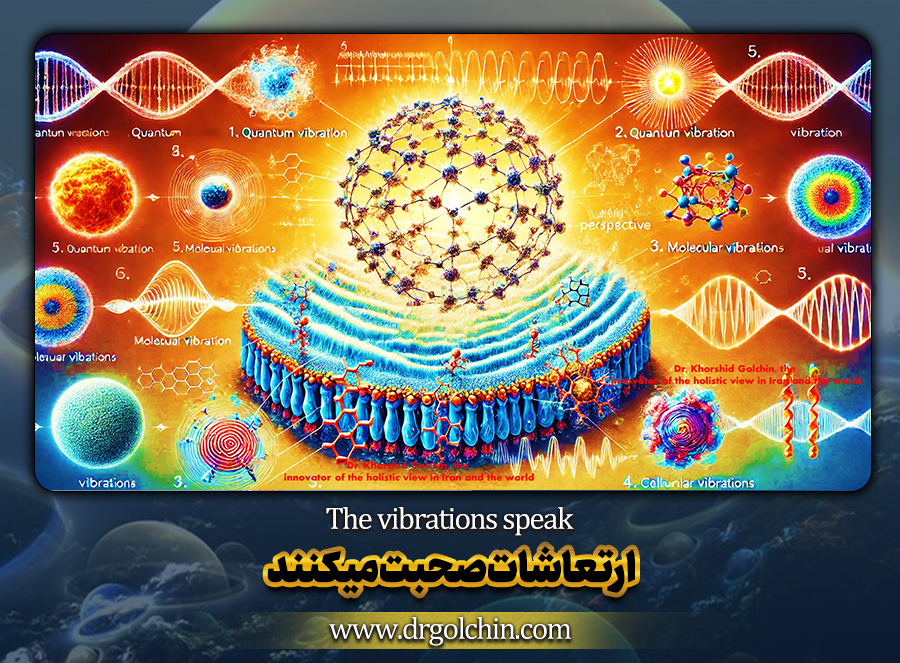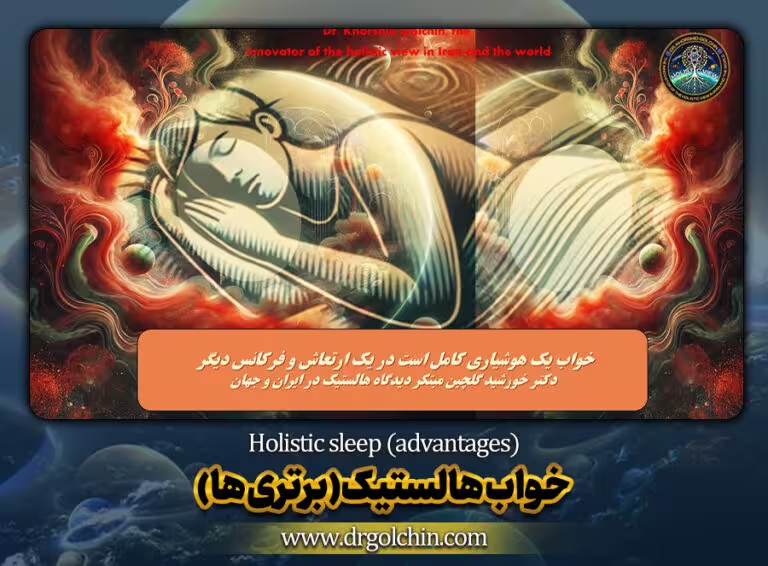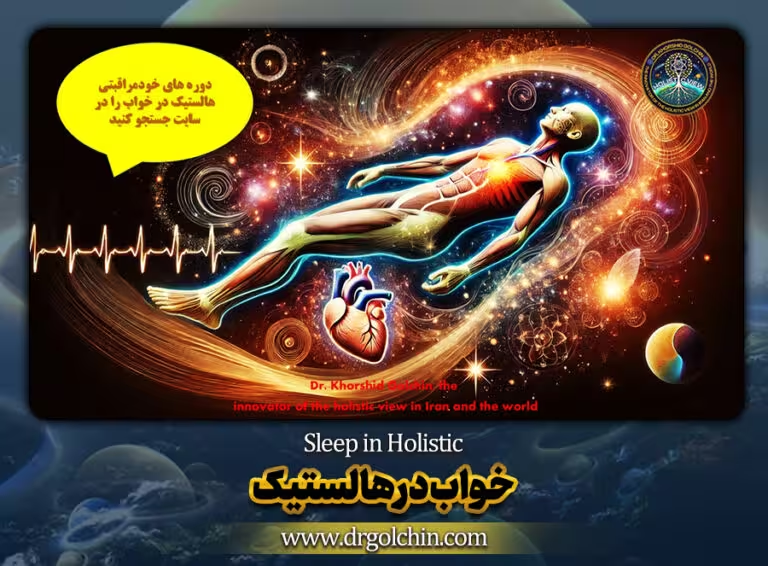ارتعاشات صحبت میکنند

من دکتر خورشید گلچین مبتکر دیدگاه هالستیک در ایران و جهان هستم،معتقدم که ارتعاش همان لرزش موجود در ذرات کوآنتومی و ملکولی و سلولی است که باعث تولید گوناگونی و تنوع در پدیده ها می شود. دیدگاه من که ارتعاش را بهعنوان لرزش موجود در ذرات کوآنتومی، مولکولی و سلولی تبیین میکند و آن را بهعنوان عاملی برای تولید گوناگونی و تنوع در پدیدهها میدانید، به یکی از مباحث اساسی در فیزیک و فلسفه علمی اشاره دارد. این تحلیل با تمرکز بر سه سطح اصلی، یعنی ذرات کوآنتومی، مولکولی، و سلولی، بررسی میکند که چگونه ارتعاش در این سطوح میتواند به تنوع و پیچیدگی در جهان منجر شود. دیدگاه هالستیک (Holistic) من به معنای نگاه یکپارچه به پدیدهها، تأکید بر ارتباط و وابستگی میان اجزا، و در نظر گرفتن سیستمهای پیچیده بهعنوان کلیتی هماهنگ و پویا است. در ادامه با مقاله ارتعاشات صحبت میکنند همراه باشید
فهرست عناوین
ارتعاش در سطح کوآنتومی
در سطح کوآنتومی، ذرات بنیادی مانند الکترونها، پروتونها، نوترونها و فوتونها رفتارهای غیرقطعی و موجی از خود نشان میدهند. اصل عدم قطعیت هایزنبرگ نشان میدهد که موقعیت و سرعت یک ذره نمیتوانند همزمان با دقت مطلق اندازهگیری شوند. این پدیده نشاندهندهی وجود نوعی “ارتعاش” ذاتی در سطح کوآنتومی است که بهطور مستقیم قابل پیشبینی نیست.
این ارتعاشات و تغییرات در سطح کوآنتومی میتوانند به ظهور پدیدههای جدید منجر شوند. برای مثال، در فرآیند همبستگی کوآنتومی (Quantum Entanglement)، ذرات به گونهای با هم در ارتباط هستند که تغییر در یکی، بهطور آنی بر دیگری تأثیر میگذارد، حتی اگر فاصله زیادی از هم داشته باشند. این ارتباطات و ارتعاشات ذرات کوآنتومی، بهعنوان یک پایهی اساسی برای درک تنوع و پیچیدگی در جهان مورد توجه قرار میگیرد.
ارتعاش در سطح مولکولی
در سطح مولکولی، ارتعاشات بهصورت حرکتهای مختلف در پیوندهای شیمیایی میان اتمها دیده میشود. این حرکتها شامل کشش و فشردگی، خمیدگی، و پیچش پیوندها میشود. این ارتعاشات نهتنها از خواص ذاتی مولکولها ناشی میشوند، بلکه تحت تأثیر شرایط محیطی مانند دما، فشار و میدانهای الکتریکی و مغناطیسی قرار دارند.
ارتعاشات مولکولی نقش مهمی در واکنشهای شیمیایی دارند. برای مثال، ارتعاشات میتوانند انرژی لازم برای شکستن یک پیوند شیمیایی و ایجاد پیوندهای جدید را فراهم کنند. به همین ترتیب، فرکانسها و حالتهای مختلف ارتعاشی در مولکولها میتوانند به شکلگیری ساختارهای شیمیایی پیچیدهتر و در نهایت، مواد زیستی و غیرزیستی با ویژگیهای منحصر به فرد منجر شوند.(ارتعاشات صحبت میکنند)
ارتعاش در سطح سلولی
در سطح سلولی، ارتعاشات به اشکال مختلفی مانند نوسانات الکتریکی در غشای سلولها، ارتعاشات مکانیکی در اسکلت سلولی، و حتی ارتعاشات ناشی از تغییرات در سطح مولکولی رخ میدهند. این ارتعاشات میتوانند در فرآیندهای بیولوژیکی نظیر انتقال سیگنالهای عصبی، متابولیسم سلولی و همچنین در فرآیندهای تقسیم سلولی و ترمیم بافتها نقش داشته باشند.
برای مثال، ارتعاشات الکتریکی در قلب انسان که به نام “پتانسیلهای عمل” شناخته میشوند، اساس ضربان قلب را تشکیل میدهند. همچنین، سلولها در بافتهای مختلف بدن به طور مداوم تحت تأثیر ارتعاشات مکانیکی قرار دارند که میتواند در فرآیندهای بازسازی و رشد نقش ایفا کند.
دیدگاه هالستیک و تنوع پدیدهها
با استفاده از دیدگاه هالستیک، میتوان گفت که ارتعاشات در این سطوح مختلف به هم مرتبط هستند و سیستمهای پیچیدهای را ایجاد میکنند که همگی بهعنوان یک کل عمل میکنند. این دیدگاه نشان میدهد که ارتعاشات در سطح کوآنتومی میتوانند تأثیراتی در سطح مولکولی داشته باشند و در نهایت، به ظهور ویژگیهای جدید در سطح سلولی منجر شوند.
به عبارت دیگر، هر سیستم از زیرسیستمهایی تشکیل شده که هر یک به طور مستقل ارتعاش میکنند و این ارتعاشات با یکدیگر تعامل دارند و پدیدههای جدیدی را به وجود میآورند. این فرآیندها منجر به ظهور تنوع و پیچیدگی در جهان طبیعی میشود. (ارتعاشات صحبت میکنند)
ارتعاش و ایجاد گوناگونی در مقاله ارتعاشات صحبت میکنند
بر اساس این دیدگاه، ارتعاشات نه تنها یک پدیده فیزیکی هستند، بلکه به عنوان یک اصل بنیادی در تولید و ایجاد تنوع در طبیعت و حتی در فرهنگ و هنرها نیز مطرح میشوند. برای مثال، موسیقی بهعنوان یک شکل هنری، کاملاً وابسته به ارتعاشات صدا و فرکانسهای مختلف است که باعث ایجاد تنوع در اصوات و احساسات مختلف میشود.
در زمینه بیولوژی، تنوع ژنتیکی و تکاملی در طبیعت نیز میتواند بهعنوان نتیجهای از ارتعاشات و تغییرات در سطح مولکولی و سلولی تفسیر شود. این ارتعاشات و نوسانات در سطح مولکولی میتوانند به جهشهای ژنتیکی و تنوع زیستی منجر شوند که در نهایت به بقا و تکامل گونههای مختلف کمک میکنند.
کاربردهای عملی و نظری
در زمینه علمی، شناخت بهتر از این ارتعاشات میتواند به توسعه تکنولوژیهای جدید منجر شود. برای مثال، نانوتکنولوژی از ارتعاشات در سطح نانوذرات استفاده میکند تا خواص جدیدی در مواد ایجاد کند. همچنین در زمینه پزشکی، درک بهتر از ارتعاشات سلولی میتواند به درمانهای جدید برای بیماریهایی که ناشی از اختلالات در این سطح هستند، منجر شود.
در سطح نظری، این دیدگاه میتواند به توسعه مدلهای جدید در فیزیک، شیمی و زیستشناسی کمک کند که به جای تمرکز بر عناصر مستقل، سیستمها را بهعنوان کلیتهایی پویا و در تعامل مداوم در نظر میگیرند. (ارتعاشات صحبت میکنند)
نتیجهگیری مقاله ارتعاشات صحبت میکنند
ارتعاش، بهعنوان یک مفهوم کلیدی در سطح کوآنتومی، مولکولی و سلولی، نه تنها یک پدیده فیزیکی است، بلکه عامل اصلی تولید تنوع و پیچیدگی در جهان طبیعی است. دیدگاه هالستیک شما که این ارتعاشات را بهعنوان نیروی محرکهای برای ایجاد گوناگونی در پدیدهها میداند، بر اهمیت تعاملات پیچیده در سیستمهای طبیعی و انسانی تأکید میکند.
این نگاه یکپارچه به ارتعاشات میتواند در درک عمیقتر از جهان و توسعه روشهای جدید در علم و تکنولوژی نقش مهمی ایفا کند و باعث شود که ما به جهان نه بهعنوان مجموعهای از اجزای جداگانه، بلکه بهعنوان کلیتی پویا و در تعامل مداوم با خود و محیط اطراف بنگریم.
Dr. Khurshid Golchin is the originator of the holistic view in Iran and the world. I believe that vibration is the same vibration in quantum, molecular and cellular particles that causes variety in phenomena.
Vibration as the Source of Diversity: A Holistic Perspective
I view that vibration represents the oscillation present in quantum, molecular, and cellular particles, and serves as a driving force for diversity and complexity in phenomena, touches upon fundamental concepts in both physics and scientific philosophy. This analysis explores how vibration at these three levels—quantum, molecular, and cellular—can lead to the emergence of variety and complexity in the world. I holistic perspective, which emphasizes the interconnectedness and interdependence of parts within a system, considers complex systems as coordinated and dynamic wholes.
- Vibration at the Quantum Level
At the quantum level, fundamental particles like electrons, protons, neutrons, and photons exhibit wave-like and uncertain behaviors. The Heisenberg Uncertainty Principle states that the position and momentum of a particle cannot be precisely measured simultaneously. This phenomenon indicates the existence of an inherent “vibration” at the quantum level that is inherently unpredictable.
These vibrations and fluctuations at the quantum level can lead to the emergence of new phenomena. For example, in quantum entanglement, particles are connected in such a way that a change in one instantly affects the other, regardless of the distance between them. These connections and vibrations of quantum particles serve as a fundamental basis for understanding diversity and complexity in the universe.
- Vibration at the Molecular Level
At the molecular level, vibrations manifest as various movements within the chemical bonds between atoms. These movements include stretching, compressing, bending, and twisting of bonds. These vibrations not only arise from the intrinsic properties of molecules but are also influenced by environmental conditions such as temperature, pressure, and electric and magnetic fields.
Molecular vibrations play a crucial role in chemical reactions. For instance, vibrations can provide the necessary energy to break a chemical bond and form new ones. Similarly, different vibrational frequencies and modes within molecules can lead to the formation of more complex chemical structures and ultimately, biological and non-biological materials with unique properties.
- Vibration at the Cellular Level
At the cellular level, vibrations occur in various forms, such as electrical oscillations in cell membranes, mechanical vibrations in the cytoskeleton, and even vibrations resulting from molecular changes. These vibrations can influence biological processes like nerve signal transmission, cellular metabolism, and even cell division and tissue repair.
For example, electrical vibrations in the human heart, known as “action potentials,” are fundamental to the heart’s rhythmic beating. Additionally, cells in various tissues are constantly subjected to mechanical vibrations, which can play a role in processes such as regeneration and growth.
- Holistic Perspective and Phenomenal Diversity
Through a holistic lens, vibrations at these different levels are interconnected and create complex systems that function as unified wholes. This perspective suggests that vibrations at the quantum level can have cascading effects at the molecular level, eventually leading to the emergence of new features at the cellular level.
In other words, each system is composed of subsystems that independently vibrate, and these vibrations interact to generate new phenomena. These processes lead to the emergence of diversity and complexity in the natural world.
- Vibration and the Creation of Diversity
According to this perspective, vibrations are not merely physical phenomena; they are also a fundamental principle in generating diversity in nature, culture, and even the arts. For example, music, as an artistic form, is entirely dependent on sound vibrations and different frequencies, which create a variety of sounds and evoke different emotions.
In the realm of biology, genetic and evolutionary diversity in nature can also be interpreted as the result of vibrations and fluctuations at the molecular and cellular levels. These vibrations and oscillations can lead to genetic mutations and biological diversity, which ultimately contribute to the survival and evolution of different species.
- Practical and Theoretical Applications
In the scientific field, a better understanding of these vibrations could lead to the development of new technologies. For example, nanotechnology utilizes vibrations at the nanoscale to create new properties in materials. In medicine, a deeper understanding of cellular vibrations could lead to new treatments for diseases that result from disturbances at this level.
On a theoretical level, this perspective can contribute to the development of new models in physics, chemistry, and biology that, rather than focusing on independent elements, consider systems as dynamic and interacting wholes.
Conclusion
Vibration, as a key concept at the quantum, molecular, and cellular levels, is not only a physical phenomenon but also a fundamental force in generating diversity and complexity in the natural world. Your holistic view that these vibrations drive the creation of diversity in phenomena underscores the importance of complex interactions within natural and human systems.
This integrated approach to vibrations can play a crucial role in deepening our understanding of the world and in developing new methods in science and technology. It encourages us to view the world not as a collection of separate parts but as a dynamic whole, constantly interacting with itself and its surroundings.
References
For further reading and reference on the subject, you can explore the following sources:
- Schlosshauer, M. (2007). Decoherence and the Quantum-To-Classical Transition. Springer.
- Moore, J. W. (1999). Molecular Vibrations: The Theory of Infrared and Raman Vibrational Spectra. Dover Publications.
- Szent-Györgyi, A. (1968). Bioenergetics. Academic Press.
- Capra, F. (1997). The Web of Life: A New Scientific Understanding of Living Systems. Anchor Books.
These references provide a solid foundation for understanding the interplay between vibrations and the creation of complexity and diversity in nature.





